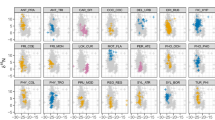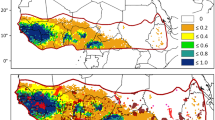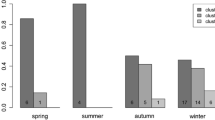Abstract
Quantifying the strength of migratory connectivity or the degree to which breeding and wintering populations are connected is crucial for conservation and management of migratory birds. Using stable hydrogen isotope ratios of secondary flight feathers (δ 2Hf), we assessed the breeding origins/locations of 666 common pochards (Aythya ferina) and 190 tufted ducks (A. fuligula) captured in France during the 2005–2006 and 2008–2009 wintering seasons. Isotopic values of common pochards wintering on Grand-lieu Lake (western France) displayed a marked bimodal spatial distribution supportive of strong contributions of both northern (60–65° of latitude) and central European (45–55° of latitude) origins. According to the temporal distribution of δ 2Hf values, the presence of common pochards of northern origin reached a maximum at the peak of the wintering season (December–January). In contrast, tufted duck did not display a clear bimodal pattern in δ 2Hf, with individuals displaying a more northerly origin (60–70° of latitude), likely of Russian and Scandinavian origin. First-year individuals had more northern origins than adults, suggesting that either isotopic discrimination differed among age groups or, more probably, that some adults may undergo moult at latitudes lower than that of their breeding ground. Tufted ducks with northerly δ 2Hf values were observed early in the season in individuals sampled in eastern France and late in the season in those sampled in western France. The effects of winter severity on the distribution of individuals over the wintering range were supported for the tufted duck with more northerly values recorded during harsh winters. Management implications of these results are discussed.




Similar content being viewed by others
References
Alexander WC (1983) Differential distribution of wintering diving ducks Aythyini in North America. Amer Birds 37:26–29
Anderson DR (2008) Model based inference in the life sciences: A primer on evidence. Springer, New York
Arnold TW (2010) Uninformative parameters and model selection using Akaike’s Information Criterion. J Wild Manage 74:1175–1178
Ashley P, Hobson KA, Van Wilgenburg SL, North N, Petrie SA (2010) Linking canadian harvested juvenile American Black Ducks to their natal areas using stable isotope (δD, δ 13C, and δ 15N) methods. Avian Conserv Ecol 5:7
BirdLife-International and Nature Serve (2014) Bird species distribution maps of the world. BirdLife International, Cambridge, UK and Nature Serve, Arlington, USA
Bowen GJ, Wassenaar LI, Hobson KA (2005) Global application of stable hydrogen and oxygen isotopes to wildlife forensics. Oecologia 143:337–348
Burnham KP, Anderson DR (2002) Model selection and multi-model inference: a practical information-theoretic approach. Springer-Verlag, New York
Cade BS (2015) Model averaging and muddled multimodel inference. Ecology 96:2370–2382
Caizergues A et al (2011) Emigration rates and population turnover of teal Anas crecca in two major wtelands of western Europe. Wildl Biol 17:373–382
Carbone C, Owen M (1995) Differential migration of the sexes of Pochard Aythya ferina: results from a European survey. Wildfowl 46:99–108
Chabot AA, Hobson KA, Van Wilgenburg SL, McQuat GJ, Lougheed SC (2012) Advances in linking wintering migrant birds to their breeding-ground origins using combined analyses of genetic and stable isotope markers. PLoS ONE 7:e43627
Clark RG, Hobson KA, Wassenaar LI (2006) Geographic variation in the isotopic (δD, δ 13C, δ 15N, δ 34S) composition of feathers and claws from lesser scaup and northern pintail: implications for studies of migratory connectivity. Can J Zool 84:1395–1401
Clark RG, Hobson KA, Wassenaar LI (2009) Corrigendum-Geographic variation in the isotopic (δD, δ13C, δ 15N, δ 34S) composition of feathers and claws from lesser scaup and northern pintail: implications for studies of migratory connectivity. Can J Zool 87:553–554
Freckleton RP (2011) Dealing with collinearity in behavioural and ecological data: model averaging and the problems of measurement error Behavioral. Ecol Sociobiology 65:91–101
Gauthreaux SAJ (1982) The ecology and evolution of avian migration systems. In: Farner DS, King JR (eds) Avian Biology, vol 6. Academic Press, New York, pp 93–168
Gourlay-Larour M-L (2013) Les déplacements et leurs implications démographiques pour les oiseaux migrateurs soumis aux prélèvements cynégétiques: l’exemple du Fuligule milouin et du Fuligule morillon. Movements and their demographic implications in harvested migratory birds: the common pochard and tutfed duck as biological models. Ph. D. Thesis, Université Nantes-Angers, ONIRIS Nantes, France
Gourlay-Larour M-L, Pradel R, Guillemain M, Guitton J-S, L’Hostis M, Santin-Janin H, Caizergues A (2014) Movement Patterns in a Partial Migrant: A Multi-Event Capture-Recapture Approach. PLoS ONE 9:e96478
Gourlay-Larour M-L, Pradel R, Guillemain M, Santin-Janin H, L’hostis M, Caizergues A (2013) Individual turnover in Common pochards wintering in western France. J Wildl Manage 77:477–485
Gourlay-Larour M-L, Schricke V, Sorin C, L’Hostis M, Caizergues A (2012) Movements of wintering diving ducks: new insights from nasal saddled individuals. Bird Study 59:266–278
Guillemain M, Van Wilgenburg SL, Legagneux P, Hobson KA (2014) Assessing geographic origins of Teal (Anas crecca) through stable-hydrogen (δ 2H) isotope analyses of feathers and ring-recoveries. J Ornithol 155:165–172
Guillemain M, Aubry P, Folliot. B, Caizergues A (in press) Duck hunting bag estimates for the 2013-14 season in France. Wildfowl
Gunnarsson G et al (2012) Disease dynamics and bird migration—linking mallards Anas platyrhynchos and subtype diversity of the influenza A virus in time and space. PLoS ONE 7:e35679
Haché S, Hobson K, Villard M-A, Bayne E (2012) Assigning birds to geographic origin using feather hydrogen isotope ratios (δ2H): importance of year, age, and habitat. Can J Zool 90:722–728
Hallworth MT, Marra PP (2015) Miniaturized GPS tags identify non-breeding territories of a small breeding migratory songbird. Scientific reports 5:art 11069
Hawkes C (2009) Linking movement behaviour, dispersal and population processes: is individual variation a key? J Anim Ecol 78:894–906
Heath MF, Evans MI (eds) (2000) Important bird areas in Europe: priority sites for conservation. BirdLife Conservation Series No. 8, Cambridge UK
Hobson KA (2003) Making migratory connections with stable isotopes. In: Avian migration. Springer-Verlag, Berlin, pp 379-391
Hobson KA (2008) Applying isotopic methods to tracking animal movements. Terrestrial Ecol 2:45–78
Hobson KA, Wassenaar LI (2008) Tracking animal migration with stable isotopes vol 2. Academic Press, London
Hobson KA, Lormée H, Van Wilgenburg SL, Wassenaar LI, Boutin J-M (2009a) Stable isotopes (δD) delineate the origins and migratory connectivity of harvested animals: the case of European woodpigeons. J Appl Ecol 46:572-581
Hobson KA, Van Wilgenburg S, Wassenaar LI, Hands H, Johnson WP, O’Meilia M, Taylor P (2006) Using stable hydrogen isotope analysis of feathers to delineate origins of harvested Sandhill Cranes in the central flyway of North America. Waterbirds 29:137–147
Hobson KA, Wunder MB, Van Wilgenburg SL, Clark RG, Wassenaar LI (2009b) A method for investigating population declines of migratory birds using stable isotopes: origins of harvested lesser scaup in North America. PLoS One 4:e7915
Hobson KA, Van Wilgenburg SL, Ferrand Y, Gossman F, Bastat C (2013) A stable isotope (δ 2H) approach to deriving origins of harvested woodcock (Scolopax rusticola) taken in France. Eur J Wildl Res 59:881–892
Keller I, Korner-Nievergelt F, Jenni L (2009) Within-winter movements: a common phenomenon in the Common pochard Aythya ferina. J Ornithol 150:483–494
Ketterson ED, Nolan VJ (1983) The evolution of differential bird migration. Curr Orn 1:357–402
Lebreton J-D, Burnham KP, Clobert J, Anderson DR (1992) Modelling survival and testing biological hypotheses using marked animals: a unified approach with case studies. Ecol Monogr 62:67–118
Legagneux P, Clark RG, Guillemain M, Eraud C, Théry M, Bretagnolle V (2012) Large‐scale geographic variation in iridescent structural ornaments of a long-distance migratory bird. J A Biol 43:355–361
Mazerolle M (2012) AICcmodavg: model selection and multimodel inference based on (Q) AIC (c). R package version 1.26. R Project for Statistical Computing Vienna, Austria
Mooij JH (2005) Protection and use of waterbirds in the European Union Beiträge zur Jagd und Wildforschung 30:49-76
Newton I (2008) The migration ecology of birds. Academic Press, Elsevier, London
Newton I (2011) Migration within the annual cycle: species, sex and age differences. J Ornithol 152:S169–S185
Nichols JD (1996) Sources of variation in migratory movements of animal populations: statistical inference and a selective review of empirical results for birds. In: Population dynamics in ecological space and time. University of Chicago Press, Chicago, pp 147–197
R-Core-Team (2014) R: A language and environment for statistical computing. R Foundation for Statistical Computing, Vienna, Austria. 2013. ISBN 3-900051-07-0
Reeber S (2012) Suivi ornithologique du lac de Grand-lieu. Bird monitoring on Grand-lieu lake. Société Nationale de Protection de la Nature. www.snpn.com
Richardson W (1990) Timing of bird migration in relation to weather: updated review. In: Bird migration. Spinger-Verlag, Berlin, Heidelberg, pp 78-101
Rodrigues DJC, Fabiâo AMD, Figueiredo MEMA (2001) The use of nasal markers for monitoring mallard populations. In: Fields R, Waren RJ, Okarma H, Sievert PR (eds) Wildlife, land, and people: priorities for the 21st century, Prooceending of the second International Wildlife Management Congress, Hungary. The Wildilfe Society, Bethesda
Rousselot JC, Trolliet (1991) Critères de détermination du sexe et de l’âge des canards. Office National de la Chasse, Paris
Royle JA, Rubenstein DR (2004) The role of species abundance in determining breeding origins of migratory birds with stable isotopes. Ecol Appl 14:1780–1788
Rubenstein DR, Hobson KA (2004) From birds to butterflies: animal movement patterns and stable isotopes. TREE 19:256–263
Salomonsen F (1968) The moult migration. Widlfowl 19:5–24
Scott DA, Rose P (1996) Atlas of Anatidae populations in Africa and Western Eurasia vol 41. Wetland International Pubication. Wetland International, Wageningen
Snow DW, Perrins CM (eds) (1998) The birds of the Western palearctic. Concise Edition vol 1 Non-Passerines. Oxford University Press, Oxford
Studds CE, McFarland KP, Aubry Y, Rimmer CC, Hobson KA, Marra PP, Wassenaar LI (2012) Stable-hydrogen isotope measures of natal dispersal reflect observed population declines in a threatened migratory songbird. Divers Distrib 18:919–930
Szabolcs N, Flink S, Langendoen T (2014) Waterbird trends 1988-2012 - Results of trend analyses of data from the International Waterbird Census in the African-Eurasian Flyway. Wetlands International, Ede, The Netherlands
Thorup K, Korner‐Nievergelt F, Cohen EB, Baillie SR (2014) Large-scale spatial analysis of ringing and re‐encounter data to infer movement patterns: A review including methodological perspectives. Methods Ecol Evol 5:1337–1350
Van Wilgenburg SL, Hobson KA (2011) Combining stable-isotope (δD) and band recovery data to improve probabilistic assignment of migratory birds to origin. Ecol Appl 21:1340–1351
Wassenaar LI, Hobson KA (2003) Comparative equilibration and online technique for determination of non-exchangeable hydrogen of keratins for use in animal migration studies. Isot Environ Health Stud 39:211–217
Webster MS, Marra PP, Haig SM, Bensch S, Holmes RT (2002) Links between worlds: unraveling migratory connectivity. TREE 17:76–83
Wetlands-International (2006) Waterbird population estimates, Fourthth edn. Wetlands International, Wageningen
Wunder MB (2010) Using isoscapes to model probability surfaces for determining geographic origins. In: West JB, Bowen GJ, Dawson TE, Tu KP (eds) Isoscapes: understanding movement, pattern, and process on Earth through isotope mapping. Springer, New York, pp 251–270
Yerkes T, Hobson KA, Wassenaar LI, Macleod R, Coluccy JM (2008) Stable isotopes (δD, δ 13C, δ 15N) reveal associations among geographic location and condition of Alaskan Northern Pintails. J Wild Manage 72:715–725
Acknowledgments
This study has been made possible thanks to the investment of numerous people. Many thank to Gilles Delacour, Christophe Sorin (Fédération des Chasseurs de Loire-Atlantique), and others for their invaluable help with captures and feather collection. Stéphanie Hennique was in charge of the feather database and sample conditioning. Special thanks to the initiator of the project, Matthieu Guillemain those help with first versions of the ms was also much appreciated. We thank Len Wassenaar for assistance with isotopic measurements. Comments of anonymous reviewers greatly helped improving the ms.
Author information
Authors and Affiliations
Corresponding author
Ethics declarations
Ethical statement
The study was performed in accordance with law of the regulations in France.
Rights and permissions
About this article
Cite this article
Caizergues, A., Van Wilgenburg, S.L. & Hobson, K.A. Unraveling migratory connectivity of two European diving ducks: a stable isotope approach. Eur J Wildl Res 62, 701–711 (2016). https://doi.org/10.1007/s10344-016-1048-3
Received:
Revised:
Accepted:
Published:
Issue Date:
DOI: https://doi.org/10.1007/s10344-016-1048-3




